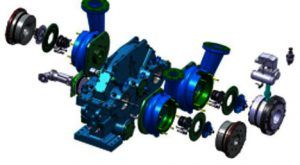Application of integrally geared compressors
Centrifugal compressors are most frequently found in the mid-flow range of the plot with pressures from 1.2 bar to over 1,000 bar. From a marketing perspective, integrally geared compressors are unique in that they compete with every type of compression technology at various points in their range of applicability. For example, at lower flow rate and lower pressure applications screw compressors are also widely used. Similarly reciprocating compressors are applied in the lower flow capacity region and are capable of producing extremely high pressures.
The article has been extracted from the paper, “Tutorial on the application and design of integrally geared compressors” by Karl Wygant, Jonathan Bygrave, Werner Bosen and Robert Pelton of Hanwha Techwin presented at the Asia Turbomachinery & Pump Symposium” in 2016.

Exploded view of integrally geared compressor[/caption]
Centrifugal blowers cover low pressure applications and are most commonly configured with single stage direct drive or driven through a step-up gear box. For high pressure applications in the mid flow zone, barrel (or inline) compressors are most common as the sealing challenges are minimized. For high flow and low pressure requirements, most frequently axial compressors are employed.
For flows below 1,000 m3/h the required pinion speeds become large and impeller sizes become too small to maintain competitive performance levels with other compression technologies. Low-cost screw compressors are typically oil flooded and will serve applications where some entrained oil is acceptable while IGCs can be oil free and cater to industries such as medical, electronics, painting, and food processing where oil free air is required.

Typical Zones of Applicability for Compressor Types,
Overlaid against IGC, for General Industry[/caption]
The required pressure ranges for plant air applications typically extend from 4 to 25 bar which means 2-, 3- or 4-stage IGCs with intercoolers between each stage with the upper limit of pressure ratio per stage of about 2.25. IGCs are also unique in that different challenges are present across the entirety of their range of application.
Comparing the industries served shown in Figure 2 with the common architectures from Figure 1 it becomes evident how the various compression technologies compete in various industries. From here it becomes relevant to describe each of the separate industries in a bit more detail to show how the complexity of the cycle changes and how this impacts the design requirements that will follow for the IGC.